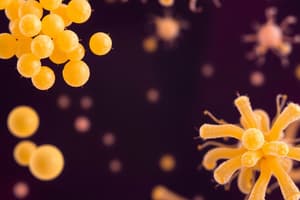Podcast
Questions and Answers
What is a key characteristic of diphtheroids?
What is a key characteristic of diphtheroids?
- They are primarily aerobic.
- They thrive in dry environments.
- They are large spherical bacteria.
- They include pleomorphic rods. (correct)
What supports the growth of Cutibacterium acnes in hair follicles?
What supports the growth of Cutibacterium acnes in hair follicles?
- High levels of oxygen.
- Frequent washing of skin.
- Low pH levels.
- Secretions from oil glands. (correct)
Which of the following bacteria is associated with acne?
Which of the following bacteria is associated with acne?
- Rickettsiae spp.
- Staphylococcus spp.
- Corynebacterium xerosis
- Cutibacterium acnes (correct)
What is the pH range of healthy skin maintained by bacterial activity?
What is the pH range of healthy skin maintained by bacterial activity?
Which of the following conditions is associated with Malassezia furfur?
Which of the following conditions is associated with Malassezia furfur?
What component in dandruff shampoos is active against Malassezia furfur?
What component in dandruff shampoos is active against Malassezia furfur?
Which manifestation of skin infections is a small flat area of discoloration?
Which manifestation of skin infections is a small flat area of discoloration?
Which bacteria are commonly considered part of the normal skin flora?
Which bacteria are commonly considered part of the normal skin flora?
Which type of mycoses affects the deeper layers of the skin?
Which type of mycoses affects the deeper layers of the skin?
Which test is used to identify Staphylococcus aureus?
Which test is used to identify Staphylococcus aureus?
What color do S.aureus colonies typically appear on culture?
What color do S.aureus colonies typically appear on culture?
Which of the following species is coagulase positive?
Which of the following species is coagulase positive?
Which clinical infection is associated with deep localized infections?
Which clinical infection is associated with deep localized infections?
What is the primary characteristic of beta-hemolytic S.aureus colonies?
What is the primary characteristic of beta-hemolytic S.aureus colonies?
In which group is impetigo generally observed?
In which group is impetigo generally observed?
What resistance characteristic does S.saprophyticus exhibit?
What resistance characteristic does S.saprophyticus exhibit?
What is the typical administration method for Penicillin G in patients with rheumatic fever?
What is the typical administration method for Penicillin G in patients with rheumatic fever?
Which of the following is a characteristic of tuberculoid leprosy?
Which of the following is a characteristic of tuberculoid leprosy?
Which clinical manifestation is associated with severe necrotizing pneumonia?
Which clinical manifestation is associated with severe necrotizing pneumonia?
What is commonly associated with M.leprae infection?
What is commonly associated with M.leprae infection?
Which organism is catalase positive among staphylococci?
Which organism is catalase positive among staphylococci?
Furuncles are associated with which symptoms?
Furuncles are associated with which symptoms?
Compared to lepromatous leprosy, which type of leprosy manifests earlier?
Compared to lepromatous leprosy, which type of leprosy manifests earlier?
Which treatment is appropriate for patients allergic to Penicillin?
Which treatment is appropriate for patients allergic to Penicillin?
What is the typical transmission route for M.leprae?
What is the typical transmission route for M.leprae?
What characterizes a macule?
What characterizes a macule?
Which skin lesion is typically raised and filled with pus?
Which skin lesion is typically raised and filled with pus?
What happens to small lesions over time according to the information provided?
What happens to small lesions over time according to the information provided?
What is the commonly observed characteristic of bullae?
What is the commonly observed characteristic of bullae?
Which skin lesion involves a loss of epidermis and is usually deeper?
Which skin lesion involves a loss of epidermis and is usually deeper?
What type of skin lesion is an erythematous macule typically associated with?
What type of skin lesion is an erythematous macule typically associated with?
What is a characteristic feature of vesicles?
What is a characteristic feature of vesicles?
Which lesion is characterized by an accumulation of fluid causing swelling?
Which lesion is characterized by an accumulation of fluid causing swelling?
Which skin lesion is often the first sign of an infectious disease?
Which skin lesion is often the first sign of an infectious disease?
What typically happens to lesions based on the type of etiologic agent?
What typically happens to lesions based on the type of etiologic agent?
What is a maculopapular skin rash?
What is a maculopapular skin rash?
What infection is associated with lepromatous leprosy?
What infection is associated with lepromatous leprosy?
What type of lesions can be described as pustules?
What type of lesions can be described as pustules?
Which of the following conditions is primarily associated with petechiae?
Which of the following conditions is primarily associated with petechiae?
What size are vesicles typically?
What size are vesicles typically?
Which of the following describes a nodule?
Which of the following describes a nodule?
What causes an abscess?
What causes an abscess?
What is the characteristic look of petechiae?
What is the characteristic look of petechiae?
Which infection is commonly associated with purpura?
Which infection is commonly associated with purpura?
What does a pustule start as?
What does a pustule start as?
Flashcards are hidden until you start studying
Study Notes
Skin Normal Flora
- Diphtheroids are pleomorphic rods that include Cutibacterium (Propionibacterium) acnes, typically anaerobic, and inhabit hair follicles
- C. acnes growth is supported by oil gland (sebum) secretions, making it a factor for acne
- C. acnes produce propionic acid, maintaining skin's low pH (3-5)
- Other diphtheroids such as Corynebacterium xerosis are aerobic and occupy the skin surface
- Malassezia furfur is associated with dandruff and is targeted by dandruff shampoos containing ketoconazole, zinc pyrithione, or selenium sulfide
Manifestations of Skin Infections
- Macule is a flat, circumscribed, erythematous discoloration, starting as small lesions and coalescing to form larger lesions
- Papule is a solid, elevated lesion, <5mm in diameter
- Nodule is a solid lesion >5mm in diameter, often seen in subcutaneous mycosis and leprosy
- Pustule is a collection of WBCs and pus, starting as folliculitis and progressing to boils (furuncle)
- Vesicle/Bullae is a collection of fluid <0.5 cm in diameter
- Ulcer is an excavation in the surface of the skin or mucous membranes, commonly seen in sexually transmitted infections
Bacterial Agents of Skin Infection
- Staphylococcus spp. are gram-positive cocci, typically arranged in clusters
- Staphylococcus aureus is coagulase positive and produces golden yellow colonies
- S. aureus is a common cause of skin infections such as folliculitis, furuncles, carbuncles, impetigo, and more serious infections like osteomyelitis, arthritis, and endocarditis
- Staphylococcus epidermidis is coagulase negative and produces white to gray colonies
- S. epidermidis is part of the normal skin flora but can cause infections in immunocompromised individuals
- Staphylococcus saprophyticus is coagulase negative, produces white to grey colonies, and is associated with UTIs in young women
- Streptococcus spp. are gram-positive cocci, typically arranged in chains
- Streptococcus pyogenes is beta-hemolytic and produces clear zones around colonies on blood agar plates
- S. pyogenes is a cause of impetigo, cellulitis, and more serious infections like necrotizing fasciitis and streptococcal toxic shock syndrome
- Rickettsiae spp. are obligate intracellular bacteria and transmitted by arthropod vectors
- Rickettsia rickettsii is the causative agent of Rocky Mountain Spotted Fever and causes rash, fever, and headache
Superficial Mycoses
- Superficial mycoses are fungal infections of the skin and hair, typically caused by Malassezia furfur, Trichophyton, Microsporum, and Epidermophyton
- Malassezia furfur causes pityriasis versicolor (tinea versicolor), characterized by hypopigmented or hyperpigmented patches on the skin
- Trichophyton spp. cause tinea corporis (ringworm), tinea cruris (jock itch), and tinea pedis (athlete's foot)
- Microsporum spp. cause tinea capitis (scalp ringworm) and tinea corporis
- Epidermophyton floccosum causes tinea corporis, cruris, and pedis
Subcutaneous Mycoses
- Subcutaneous mycoses are fungal infections of the subcutaneous tissue, typically caused by Sporothrix schenckii, Blastomyces dermatitidis, Coccidioides immitis, and Histoplasma capsulatum
- Sporothrix schenckii causes sporotrichosis, a chronic granulomatous infection that spreads along lymphatic vessels
- Blastomyces dermatitidis causes blastomycosis, a pulmonary infection that can spread to the skin and other organs
- Coccidioides immitis causes coccidioidomycosis, a pulmonary infection that can spread to the skin and other organs
- Histoplasma capsulatum causes histoplasmosis, a pulmonary infection that can spread to the skin and other organs
Mycobacterium leprae : Pathogenesis
- Transmitted from person to person via respiratory droplets, skin lesion exudates, or abrasions
- Low infectivity with a long incubation period (years)
- Genetic predisposition influences susceptibility
- M. leprae is an obligate intracellular pathogen and infects macrophages and Schwann cells
Mycobacterium leprae : Clinical Infections
- Chronic granulomatous condition affecting peripheral nerves and mucocutaneous tissues
- Tuberculoid leprosy presents with large macules in cooler body regions (nose, ear lobes, testicles), neuritis (anesthesia), and a hypopigmented macule
- Lepromatous leprosy is characterized by skin lesions, nodules, and infiltrations with a high bacterial load
- Leprosy is treated with multidrug therapy
Gram Staining and Identification of Staphylococcus spp.
- S. aureus stains gram-positive and is catalase positive (produces bubbles when hydrogen peroxide is added)
- S. aureus is also coagulase positive, meaning it can coagulate plasma
- S. epidermidis and S. saprophyticus are gram-positive, catalase positive, but coagulase negative
- S. epidermidis is susceptible to novobiocin, while S. saprophyticus is resistant
- S. aureus can also be differentiated by its golden yellow colonies, while S. epidermidis and S. saprophyticus produce white to grey colonies.
Studying That Suits You
Use AI to generate personalized quizzes and flashcards to suit your learning preferences.




